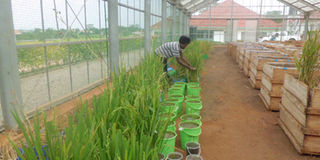Scientists develop maize and rice that grow in soils with less nutrients and no fertiliser

A rice breeder examines rice varieties that have shown signs of surviving in soils with no nitrogen. If the field trials are successful, these will be rolled out to the farmers. Photo by Lominda Afedraru.
What you need to know:
Fertiliser use by Ugandan farmers compared to other African countries is almost negligible. While there are several factors to explain this, researchers are developing varieties to overcome this challenge.
Since farmers in Uganda do not make much use of fertiliser to boost their yields, scientists and breeders are developing cereal varieties, which can thrive on less nitrogen.
The scientists who started this initiative two years ago, especially in rice research, have already prepared sites at the National Crop Resources Research Institute (NaCRRI) in Namulonge and are awaiting the next planting season to start the field trials.
In the lab and field
The main aim of conducting this research is because most farmers do not use fertilisers, thus the need to avail them with varieties that grow with less nutrients in the soil.
They began by draining nitrogen from the soil by planting sorghum whose root nodules are good for the drainage process.
According to Dr Geoffrey Asea, head of the cereal department at NACRRI, sorghum has been planted for two seasons without using fertiliser.
With the maize variety trial, the breeding is done using the conventional method, where after evaluating the results and proving they can grow in soils with less nitrogen, the varieties will be released to farmers.
“After breeding the maize varieties in the greenhouse, we look at the effects of less nitrogen on the plants. Those that have yellow leaves are taken to be those which cannot withstand soils with less nitrogen and we select those that are tolerant to the soil condition,” Dr Asea said.
“These are the varieties, which we are taking to the trial site for further testing and evaluation.”
The maize varieties will be planted in the July/ August planting season but the rice varieties are set for planting next month.
Dr Jimmy Lamo, who is leading the rice research, explained that the exercise has been going on in the laboratory since 2008 using the transgenic breeding mechanism.
Closely related
He added that famers have been faced with the challenge of growing rice in areas with less rain and that is the reason why his team is breeding a variety to enable them over this problem.
The team obtained genes from rice and barley that was bred by scientists from the University of California, US, and have been sequencing it into the local rice varieties.
This was through support of the US Agency for International Development (USAID) while the maize varieties were obtained through the African Agricultural Technology Foundation (AATF), which sources for agricultural materials with funding from Bill and Melinda Gates Foundation.
However, according to Dr Lamo, his team prefers to use the genes from rice than from barley because the former are from closely related species.
More data
“We have been breeding rice varieties using conventional mechanism where closely related two parents are crossed using simple pollination method, which many farmers have adopted but we want to grow rice in those extreme places where there is little rain and poor soil fertility,” he explained, adding that it is for farmers living in such areas to engage in growing rice to improve their household income.
The team is generating more data for farmers on whether to use rice varieties that are bred using conventional means or using transgenic mechanism.
The laboratory tests, which began in 2008, are to be proved effective during the field tests by producing enough grains in soils with less nutrients and without fertiliser. If so, then it will be of benefit to farmers but the team also has a challenge of releasing the varieties without a law on biosafety in place.




